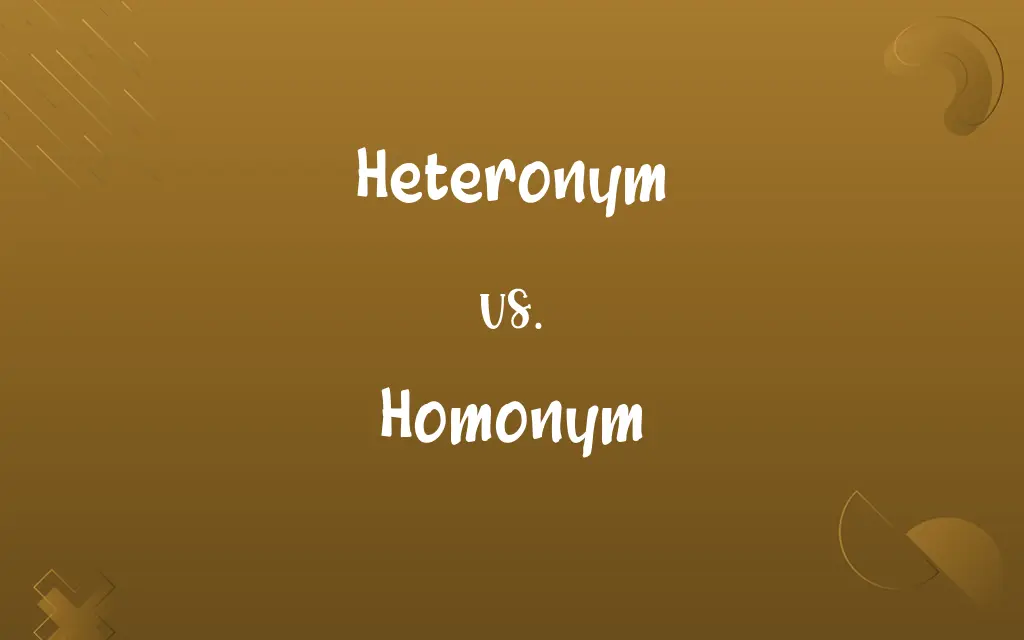Heteronym vs. Homonym: Know the Difference

By Dua Fatima & Shumaila Saeed || Updated on March 4, 2024
Heteronyms are words spelled identically but with different meanings and pronunciations, while homonyms are words that sound alike but may differ in spelling and meaning.

Key Differences
Heteronyms are a fascinating aspect of English, characterized by a shared spelling between two words that diverge in both meaning and pronunciation. For instance, "lead" (to guide) versus "lead" (a metal). This linguistic feature highlights the complexity and richness of the language, demonstrating how context is crucial in understanding pronunciation and meaning. On the other hand, homonyms encompass a broader category, including words that sound the same but may have different spellings and meanings, such as "bear" (the animal) and "bare" (to uncover). Homonyms underscore the phonetic overlaps in English, where distinct words converge in sound, regardless of their spelling or semantic differences.
Shumaila Saeed
Mar 04, 2024
With heteronyms, the emphasis is on the phonetic diversity that a single spelling can represent, such as "tear" (to rip) versus "tear" (a drop of liquid from the eye). This variance in pronunciation based on context or function in the sentence showcases the dynamic nature of language and the cognitive engagement required for accurate interpretation. Conversely, homonyms focus on the auditory experience of language, where words like "knight" and "night" demonstrate how entirely different meanings and origins can share the same phonetic expression. This phenomenon enriches spoken communication, adding layers of meaning and potential for wordplay.
Dua Fatima
Mar 04, 2024
Heteronyms often challenge learners and speakers with their dual demands of recognizing context to deduce the intended pronunciation and meaning, making them unique linguistic puzzles. For example, "wind" (to turn) and "wind" (air in motion) require an understanding of sentence structure and meaning for correct interpretation. Homonyms, in contrast, challenge readers and listeners to rely on context for meaning but not pronunciation, since the sound remains constant, as seen with "to," "too," and "two." The challenge here lies in grasping the nuanced differences that spelling brings to similar-sounding words.
Dua Fatima
Mar 04, 2024
In the realm of heteronyms, the duality serves as a reminder of English's etymological depth, where words like "row" (a line) and "row" (a quarrel) reflect diverse origins and uses despite identical spellings. This aspect of English invites exploration into the history and evolution of words, enriching vocabulary with stories of linguistic convergence. Homonyms, by contrast, highlight the synchronic dimension of language, where words like "flower" and "flour" coexist in sound while diverging in meaning and function. This coexistence underscores the playful and sometimes confusing aspects of English phonetics and semantics.
Shumaila Saeed
Mar 04, 2024
The study of heteronyms and homonyms not only enriches one's understanding of language but also enhances cognitive flexibility in communication. Navigating through heteronyms requires a keen sense of linguistic context and the ability to adjust pronunciation accordingly, while homonyms demand precision in choosing words that sound identical but differ in meaning or spelling. Both phenomena contribute to the dynamic interplay between written and spoken English, highlighting the importance of context, sound, and meaning in effective communication.
Dua Fatima
Mar 04, 2024
ADVERTISEMENT
Comparison Chart
Definition
Words with identical spelling, different meanings, and pronunciations.
Words that sound alike but may differ in spelling and meaning.
Shumaila Saeed
Mar 04, 2024
Example
"Lead" (to guide) vs. "lead" (a metal).
"Bear" (the animal) vs. "bare" (uncovered).
Dua Fatima
Mar 04, 2024
Pronunciation
Varies based on meaning.
Generally the same, regardless of meaning or spelling.
Dua Fatima
Mar 04, 2024
Context Dependency
High, for determining both pronunciation and meaning.
High, primarily for determining meaning.
Dua Fatima
Mar 04, 2024
Language Feature
Illustrates the depth and complexity of English spelling and pronunciation.
Highlights phonetic overlaps and the playful nature of English.
Shumaila Saeed
Mar 04, 2024
ADVERTISEMENT
Heteronym and Homonym Definitions
ADVERTISEMENT
Heteronym
Tear: (n) a drop of liquid from the eye.
A tear rolled down her cheek.
Shumaila Saeed
Mar 04, 2024
Homonym
One of two or more words that have the same sound and often the same spelling but differ in meaning, such as bank (embankment) and bank (place where money is kept).
Dua Fatima
Oct 19, 2023
Heteronym
One of two or more words that have identical spellings but different meanings and pronunciations, such as row (a series of objects arranged in a line), pronounced (rō), and row (a fight), pronounced (rou).
Dua Fatima
Oct 19, 2023
Heteronym
That which is heteronymous; a thing having a different name or designation from some other thing; - opposed to homonym.
Dua Fatima
Oct 19, 2023
Heteronym
Two words are heteronyms if they are spelled the same way but differ in pronunciation (e.g. `bow')
Dua Fatima
Oct 19, 2023
Homonym
A word having the same sound as another, but differing from it in meaning; as the noun bear and the verb bear.
Dua Fatima
Oct 19, 2023
Homonym
Two words are homonyms if they are pronounced or spelled the same way but have different meanings
Dua Fatima
Oct 19, 2023
Repeatedly Asked Queries
What are heteronyms?
Heteronyms are words that are spelled the same but have different meanings and pronunciations.
Shumaila Saeed
Mar 04, 2024
What are homonyms?
Homonyms are words that sound the same but may have different meanings and spellings.
Dua Fatima
Mar 04, 2024
Can you give an example of a heteronym?
"Lead" can mean to guide (verb) or a metal (noun), with different pronunciations.
Dua Fatima
Mar 04, 2024
How do you determine the meaning of a heteronym?
Context is key to determining the meaning and pronunciation of a heteronym.
Dua Fatima
Mar 04, 2024
How do heteronyms enrich the English language?
They add complexity and depth, illustrating the diverse origins and meanings of words.
Shumaila Saeed
Mar 04, 2024
Can you give an example of a homonym?
"Bear" can refer to carrying something (verb) or the animal (noun).
Hifza Nasir
Mar 04, 2024
What makes homonyms interesting?
Their ability to sound the same while representing different meanings or spellings adds a playful element to language.
Hifza Nasir
Mar 04, 2024
How do you pronounce heteronyms correctly?
Pronunciation depends on the word's meaning in context, which requires familiarity with both meanings.
Dua Fatima
Mar 04, 2024
Do homonyms have to sound exactly the same?
Yes, homonyms sound exactly the same, though their spelling and meaning may vary.
Dua Fatima
Mar 04, 2024
Can a word be both a heteronym and a homonym?
No, because heteronyms require different pronunciations, while homonyms sound the same.
Dua Fatima
Mar 04, 2024
Are heteronyms common in English?
Yes, they are a notable feature of the language, reflecting its richness and complexity.
Dua Fatima
Mar 04, 2024
Are homonyms and homophones the same?
Homonyms include homophones (words that sound the same) but also encompass words with different spellings.
Dua Fatima
Mar 04, 2024
Why are heteronyms challenging?
They require understanding of context to interpret the correct pronunciation and meaning.
Shumaila Saeed
Mar 04, 2024
What role does context play in understanding homonyms?
Context helps distinguish between the meanings of words that sound the same.
Dua Fatima
Mar 04, 2024
Share this page
Link for your blog / website
HTML
Link to share via messenger
About Author
Written by
Dua FatimaCo-written by
Shumaila SaeedShumaila Saeed, an expert content creator with 6 years of experience, specializes in distilling complex topics into easily digestible comparisons, shining a light on the nuances that both inform and educate readers with clarity and accuracy.









































































